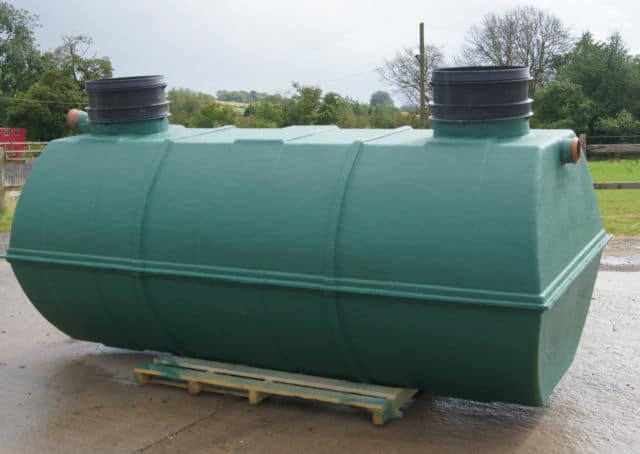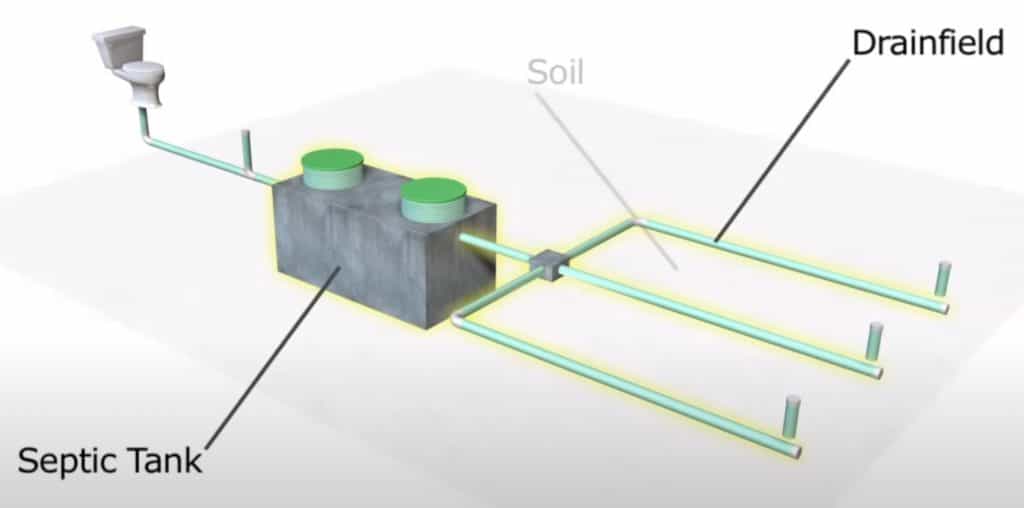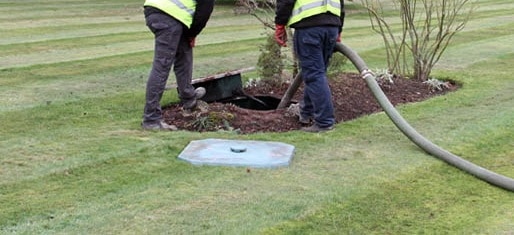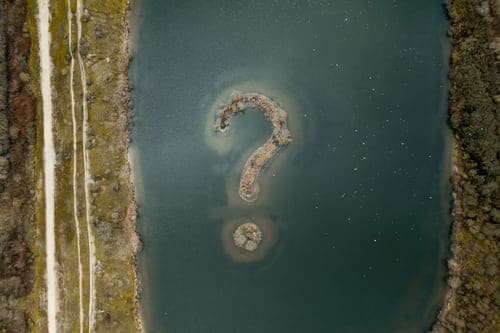Bio-Pure Low Profile Septic Tanks
available in 2 sizes and we can manufacture bespoke tanks if required
3200 Litre (6 persons)
Height – 1300 mm
Length – 2230 mm
Width – 1400 mm
Depth below invert level – 1350 mm
4800 Litre (12 persons)
Height – 1300 mm
Length – 3300 mm
width – 1400 mm
Depth below invert level – 1350 mm
What is a septic tank?
Septic Tanks are the old fashioned way of dealing with sewage. It stores solid waste and offers very little treatment to the liquid waste it accepts.
A septic tank is often made from GRP or Polyethylene and it has a foul drainage pipe connected to the inlet and a drainage pipe connected to the outlet.
From there it discharges into a soakaway or into a treatment plant where the effluent can be treated further. There are often two or three chambers inside the septic tank separated by dividing walls allowing the sewage to flow through.
The Bio-Pure Low Profile Septic Tanks feature a filtered outlet. The image shown is of the 3200 Litre Septic Tank.
**please note that the depth below invert is based on a traditional septic tank.

How does A Septic Tank Work?
Sewage enters the primary chamber of the septic tank, where solids settle at the bottom via gravity. The settled solids are anaerobically treated reducing the overall volume within the tank.
The liquid waste then flows through the dividing wall into the second chamber where further settlement takes place. The liquid is then discharged into a soakaway or if necessary, lifted to a sewage treatment system for further treatment before being discharged.
Waste will always remain in a septic tank despite the best efforts of anaerobic digestion as it offers very little treatment to settled sludge. The septic tank will eventually have to be emptied so as to prevent the sewage from overflowing into the drainage field (soakaway etc).
This is not only very bad for the environment, but it will decrease the porosity of the soil and often clog up the soak way causing the raw sewage to back up and result in costly repairs being needed.
Watch How A Septic Tank System Works
I have found this great video that will explain how a septic system works. Please remember always to consult your local authorities before you carry out work or alternately you can contact us for some impartial, friendly advice.
Septic Tank with a drain field/soakaway

Your septic tank only needs to be emptied when the solids have built up inside the septic tank.
The settled effluent from the septic tank drains into a soakaway or drainage field.
Soakaways or drainage fields are designed to further treat the effluent by bacteria that naturally occurs.
If the septic tank is working correctly and the subsoil is free draining the process will work successfully and efficiently.
Over time fine solids are passed from the septic tank into the drainage field or soakaway. The bacteria will produce some organic matter (biomass) which in turn will silt up the drainage field or soakaway.
The drainage field or soakaways efficiency will be reduced, affecting the rate at which it will be able to discharge the effluent into the subsoil.
Over time the rate of flow from the dwelling to the septic tank system is greater than the flow to the subsoil, which eventually will cause the soakaway or drainage field to back up.
What Is The Reason For A Soakaway Or Drainage Field?
For a septic tank to work and meet regulations, it has to be connected to a soakaway or drainage field. The drainage field Or soakaway is designed to spread effluent over a wide area.
Drainage fields are a system of underground irrigation pipes which let the effluent to seep into the soil to further treat the wastewater.
It is said that one of the most common problems with a soakaway or drainage field is that the system can back up. You can tell by checking the septic tank levels.
This can be caused by the drainage field or soakaway being saturated from lousy soil conditions, the water table is high or even solid matter which has gotten threw from the septic tank.
It is essential that you maintain your septic tank system. If you would like to further discuss this, we would be more than happy to help you with any question or concerns you may have, contact us today for some impartial friendly advise.
Is your Septic Tank Compliant?
Does your septic tank discharge directly to a ditch, stream, river, lake or pond?
If so, it no longer conforms to the Environment Agencies requirements. Under their guidelines you will need to upgrade or replace your current septic tank system by 1 January 2020, or when you come to sell your property if it is before this date.
For more information, please contact us today were here to help you.
Want To Learn More On How A Septic Tank System Work?
The septic tank will break down biomass and will separate solids and matter like oils and grease from the effluent.
A septic tank has 2 pipes, the inlet pipe which is connected to the dwelling to carry the wastewater to the septic tank and an outlet pipe which is connected to the soakaway or drainage field.
The wastewater and sewage settle in the septic tank and over time the solid and the liquid separate from each other letting the liquid drain from the outlet pipe into the drainage field or soakaway.
A Septic tank separates the wastewater into 3 layers
Scum Layer
The top layer, scum layer as its referred to is where oils and greases collect.
Effluent Layer
The middle layer is where the wastewater, along with other waste particles separate.
Sludge Layer
The 3rd and bottom layer are where everything that is heavier separates and settles and forms a layer of sludge.
Inside the septic tank, the bacteria’s job is to try and break down the solid waste, which in turn allows liquids to rise and then drain away.
The sludge that remains at the bottom of the septic tank will build up over time and will need emptying.
Discover The Importance Of Understanding septic tank bacteria

The bacteria in a septic tank is what makes the system function.
The bacteria breaks down wastewater and sewage, leaving wastewater clean enough for the environment and to safely percolate down into the subsoil.
The septic tank system is designed to keep the bacteria healthy and efficient.
Some of the bacteria will live in the septic tank, but most of the bacteria do their job in the soakaway or drainage fields.
All wastewater flows into the septic tank where effluent (wastewater), fills the septic tank.
Anaerobic bacteria starts the process and starts digesting the biomass (organic matter) in the wastewater.
The bottom layer is where the sludge collects, The sludge is composed of non-organic solids.
The scum layer is mainly a collection of grease, fats and oils etc. which separates and floats to the top layer. Think of the septic tank as a settling container where it gives the wastewater time to separate the light from the heavy waste.
The filter inside the septic tank helps prevent most of the solids from the effluent getting threw to the outlet pipe, more importantly, the soakaway or drainage field.
The soakaway or drainage field provides the effluent to be processed further. A drainage field is a great place for the bacteria to thrive and do its job, so the treated wastewater can safely pass threw the subsoil.
Discover Some Of The Different Types of Septic Tanks
Below are 2 of the most common types of materials that septic tanks are made from and they brick or GRP (glass reinforced plastic)
Septic Tanks Constructed From Brick
Septic tanks that are constructed from brick typically have 2 chambers. When the effluent (wastewater) reaches the height of the outlet pipe in the 1st chamber, it will then overflow into the second.
Inside the septic tank, you should find T-pipes, and they will be attached to the inlet and outlet pipes of the septic tank.
The T-pipes are vital as they retain the solid matter from the effluent inside the septic tank, thus stopping them from entering the soakaway or drainage field.
GRP Septic Tank (Glass Reinforced Plastic)
Glass Reinforced plastic septic tanks work much like the tank above as they too don’t treat the effluent and also lets the wastewater separates into 3 layers as explained earlier.
The GRP septic tank uses baffles to prevent solid matter getting threw, unlike the brick-built tank which uses T-pipes.
I have found this video for you that goes into some detail hope you find it helpful.
Please remember always to consult your local authorities before you carry out work or alternately you can contact us for some impartial, friendly advice.
Septic Tank Emptying UK

How Often do you empty a Septic Tank?
This is determined purely by the volume of the tank in relation to the amount of solids going into it, the surface area contact and also the ambient temperature, as anaerobic treatment is more effective at a higher temperature.
The emptying interval can vary greatly and often depends on usage, the diligence of the owner and also the different characteristics of each system.
Some septic tanks need de-sludging every 4-6 months while others can go for over 12 months before requiring emptying.
There is no set period of time determining how often a septic tank should be emptied.
How much does septic tank emptying cost in the UK?
After doing a bit of research, it seems that the average cost to empty a septic tank in the Uk is from £80 to £400. Please keep in mind that prices will vary from region to region, size of your system and condition your septic tank is in.


What are the signs that your septic tank is full?
- A pond you do not want (Pooling water)
- Poor drainage
- Nasty Smell
- Patches of healthy green grass (sewage acts as a fertiliser)
- Sewage starts to backup
- Pipes make gurgling noises
- Flushing issues with your toilet
Can I empty my own septic tank?
Simply put the answer is no you can’t empty your own septic tank unless you are a farmer and are going to be repurposing for agricultural use and even then it can only be used on certain agricultural land, please take a look at the requirements of the Waste Management (Use of Sewage Sludge in Agriculture)

The Bio-Pure Low Profile Septic Tanks
As well as manufacturing, installing and servicing the Bio-Pure Sewage Treatment System, we also manufacture a Low Profile Septic Tanks with a filtered outlet.
This is designed to significantly reduce installation costs and increase effluent quality.
This is achieved by a larger service area contact which increases oxidisation, thus allowing the waste to broken down more efficiently than with a traditional onion shaped septic tank, resulting in majorly reduced pollution.
The Low Profile Septic Tank also features a filtered outlet which prevents any suspended solids from entering the soakaway. Also the Low Profile Septic Tank doesn’t require the same depth as a traditional onion shaped tank, so installation costs are lowered.
- Fully designed and manufactured in accordance with BS EN12566-1
- Concrete is only required for installation in a high water table or if a greater depth is required
- We offer an adaptable invert level to cater for any individual needs
- All risers and manholes are included
- Typical emptying period of 12-18 months
- 7-10 days lead time, but can be dispatched sooner if required
The Low Profile Septic Tank is available in 2 sizes and we can manufacture bespoke tanks if required. It can also be used as a “trash tank” to sit in front of a treatment system on a larger domestic, or commercial site.
Septic Tank Installation
Delivery
You should inspect the unit for any damage, and this should be notified at the time of delivery, and the driver must record it on the delivery note. Damage notified this time may not be warranted. Please ensure that the unit is put into a safe area before installation, it is not to be put over sharp objects.
Lifting
The Bio-Pure septic tank should be lifted by means of two straps around the whole body of the unit, equally spaced. Ensure that the unit is empty of water prior to lifting and that it is balanced on the strappings.
Installation
The Bio-Pure septic tank can be installed in a dry ground installation with a gravel backfill and with an invert level of no more than 600 mm.
In a wet ground installation or with an invert level of deeper than 600 mm, the unit should be installed using concrete.
- Excavate a hole to the same dimensions as the unit plus 200 mm
- Lay a gravel base at the base of the excavation, ensure that this is level
- Lift the Bio-Pure septic tank into the hole by means of strapping around the body
- Make the inlet and outlet connections
- Backfill with gravel, at the same time filling the unit full of water. Ensure that this is done on an equal basis
- Level the ground to the desired ground level
- Cut the risers and fit the two manhole covers
*It is advisable that a ground vent or a high level vent is used to control the septic odour in the Bio-Pure septic tank. This is done by inserting a vent pipe (usually 110 mm pipe) into both access shafts.
Septic Tank Maintenance
The Bio-Pure septic tank is a two-chambered septic tank with a filtered outlet which is designed to discharge only to a ground soakaway. It is not designed to discharge to a watercourse. The unit should be emptied on an annual basis and at this time the filter in the outlet should be cleaned.
Emptying of the unit is done via both shafts, and each compartment should be emptied 50% at a time starting with the primary chamber (this is the first chamber).
The filter in the outlet can be removed by turning anti-clockwise and pulling it from its sleeve. This should be washed with a hose.
Refitting is a reverse of the removal.
Septic Tank Do's & Don'ts
What are the do's and don'ts of a septic tank?
Follow these do’s and don’ts to increase the chance of a healthy and trouble-free septic tank system.
The Do’s
- Only use recommended or vetted installers who can show that they follow legislation.
- Discharge all your wastewater from your home into the septic tank
- Know where your septic tank and soakaway are on your property
- Make sure regular inspections for your septic system are in place.
- Make sure you are desludging the tank regularly.
- If you find any problem with your tank report it and get it inspected sooner rather than later.
- Store a file of any maintenance work.
- Keep manholes and access points clear and accessible at all time.
- Regular checks of air vents, making sure they are kept clear.
- Make sure soakaways and drainage fields are protected from potential damage.
- Keep other water sources, e.g. roof, hard standing drains from your system.
- Use a dishwasher where possible as it is better at turning fat into soap.
- Use mild detergents, toilet fresheners, fabric conditioners, washing powders and washing liquids in moderation so not to upset the balance of your septic tank. Try to make sure active ingredients in your soap and detergents are biodegradable and, in normal use, should be ok for septic tanks.
- Use bleaches and disinfectants sparingly as they can kill the friendly bacteria which are essential to make the septic tank work.
- Try to spread your laundry over the week.
The Don’ts
- Don’t put fat, oil or grease into your drains
- Don’t pour paints, solvents or motor oils down your drains
- Don’t put garden chemicals and pesticides into the septic tank
- Don’t Use the toilet or kitchen sink for anything other than what’s meant to go in there
- Do not put nappies, sanitary items or plastic items into the system
- Make sure the drainage field is protected do not drive on, dig or cover with a hard surface
- Do not block any air vents and keep clear at all times
- Refrain from desludging your septic system too much
- Don’t allow effluent to collect on the top of the ground
- Never attempt to climb into or enter a septic tank as the gases that are produced can be dangerous
- Try not to do all your laundry on the same day
Frequently Asked Questions
Does your shower water go into the septic tank?
All drains from washing machines, washbasins, toilets, dishwashers, showers etc in the home lead to the inlet pipe which connects to your septic system.
How many loads of laundry can I do with a septic tank?
As you can imagine doing all your laundry in one day would be a lot of water and would put your septic tank under a lot of strain. Instead try to spread your washing over the week, while this isn’t convenient your septic system will thank you for it.
Furthermore, you’re spreading out the phosphates which are in detergents and soaps which harm the good bacteria in your system plus always try to buy soaps and detergents that are low in phosphates.
What can you put in a septic tank to break down solids?
I have found these Septic Tank Bacteria BioBoost Tablets that also seem to be very good. After I had spoken with the company they told me they were very popular, but I must say we have never tried them so please do your research, here’s a link to there data sheet hope this provides you with the information you need.
How do I clean my septic tank naturally?
A natural option is to use yeast as this helps to keep the good bacteria alive to help break down waste solids actively. For the first time put half a cup of instant dry baking yeast down your toilet then a quarter cup every four months after.
What is the best septic tank treatment?
Here are three options that seem to be the most popular at the time of writing this.
- Septic Shock extra-strong bacteria and enzyme treatment – By BIO-ENZYM Ltd
- Corsodyl Gum Problem Treatment Spray, 60 ml – By Corsodyl
- Septic Tank Maintenance – By BiOWiSH
What toilet paper is best for septic tanks?
11 toilet papers you can try for your septic system
- CHARMIN ULTRA STRONG CLEAN TOUCH TOILET PAPER
- CHARMIN ULTRA SOFT CUSHIONY TOUCH TOILET PAPER
- SCOTT RAPID-DISSOLVING TOILET PAPER
- MEGA ROLL TOILET PAPER
- COTTONELLE ULTRA CLEAN CARE TOILET PAPER
- SCOTT SHEETS PER ROLL TOILET PAPER
- SCOTT COMFORT PLUS TOILET PAPER
- QUILTED NORTHERN ULTRA PLUSH TOILET PAPER
- COTTONELLE ULTRA COMFORT CARE TOILETPAPER
- PRESTO! FLEX-A-SIZE PAPER TOWELS
- ENVISION 1-PLY EMBOSSED TOILET PAPER
Does hair dissolve in a septic tank?
Always try to discard human and animal hair straight into your waste bin as both will not decompose and may cause issues with your septic system in the future.
Can I use bleach if I have a septic tank?
Ordinary household bleach should be ok as long as it is diluted and used sparingly. It won’t have much of an effect on the good bacteria within the septic system, as the chemicals in household bleach generally have low quantities, and are not strong enough to affect the good bacteria. How ever as with all chemicals, try only to use household bleach in moderation.
How do I get rid of sludge in my septic tank?
7 ways to help reduce sludge in A Septic Tank System
- Pumping or Cleaning
- Aeration and Bio-Enzymes, Microbes and Bio-Activators
- Install an aeration system with diffused air in your septic tank
- Break up any compacted sludge
- Add a bio-activator or microbe blend
- Maintain the aeration system
- Add additional Microbes as required
How do I add good bacteria to my septic tank?
If you have been advised to add bacteria to your septic system, the most common way to usually do this is merely dropping the bacteria of use choice straight down your toilet.
What cleaning products can I use with a septic tank?
Most of the usual house cleaners are ok to use with septic systems in moderate amounts, for peace of mind, you should use septic-safe products which should be indicated on the label.
In Small amounts cleaning products that have bleach is ok to use with your septic systems, mild detergents, soaps etc. but try to use Phosphate-free detergents that are low-sudsing are best.
Try not to use chemicals where you would be required to wear gloves. Cleaning products containing ammonia, as well as pure ammonia, are also safe for septic system use in small amounts. Many water-based cleaners, such as water-based carpet cleaners, tub and toilet cleaners, and disinfectants are reliable for septic use.
I have spoken with Ecozone, and they have assured me that their products are septic safe but as always before using any cleaning products read the label and any data sheets that are available before use.
USEFUL ADVICE ABOUT SEWAGE TREATMENT PLANTS & SEPTIC TANK REPLACEMENT
What is 2020?
Discharges from septic tanks directly to a surface water are not allowed under the general binding rules.
If you have a septic tank that discharges directly to a surface water you will need to replace or upgrade your treatment system by 1 January 2020, or when you sell your property if before this date.
If the Environment Agency finds evidence that your septic tank discharging to a surface water is causing pollution, you will need to replace or upgrade your system earlier than 1 January 2020.
Will my Bio-Pure Sewage Treatment Plant really run up to 5 years without requiring emptying?
Yes. A typical Sewage Treatment Plant will, but it must be remembered that the tank relies on bacteria to eat the sewage. A few simple steps will ensure your plant runs for 5 years between emptying.
Can I use household cleaning products when my Bio-Pure Sewage Treatment Plant is installed?
Yes, but the cleaning products must be used in sensible quantities, remember that the chemicals can destroy the bacteria, which is essential to enable the system to work effectively. See the page ‘Do’s and Don’ts for guidelines on using the Bio-Pure.
What is population equivalent?
In simple terms, this is usually the number of bedrooms in your property plus 2. i.e. a 3 bedroom property is classed as 5 persons and a 4 bedroom property is classed as 6 persons. Please note that this only refers to residential property. For non-residential property the population equivalent differs depending on the purpose of the property (i.e. kitchen, campsite etc). Please contact us so that we can tell you the correct size Bio-Pure that would be needed.
Do you install the Bio-Pure Sewage Treatment Plants?
Yes we do install in some areas, in other areas we work with independent contractors.
How far must the Bio-Pure be situated from the house?
Building regulations have a guideline of 7m a treatment system being at least at least 7m away from the domestic dwelling, this can be dealt with on a case by case basis.
Does the Bio-Pure meet the requirements to discharge to a water causeway?
Yes, the Bio-pure meets the Environment Agency’s requirements for discharging under the general binding rules. The Bio-Pure has been tested at a PIA Centre in Germany (EN12566-3)
What is the discharging regulations and do I need it?
Discharging from a treatment system or septic tank has certain a legal requirement from the Environment Agency.
It is now broken down into a General binding rule and a permit to discharge. Everyone should find out if they come under the general binding rules or if they require a permit to discharge.
If you have any doubts contact us and speak to one of the team who can assist you.
